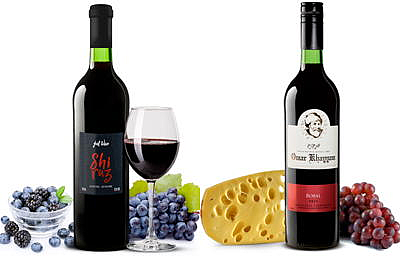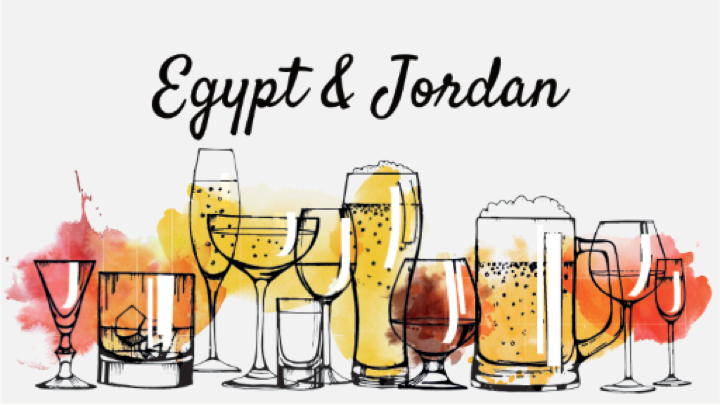In part 1 of his review of the wines of the Middle East and North Africa and their history, Paul McCarthy explores wine production in Egypt and Jordan.
Egypt
On my first business trip to Cairo—not to sample wines I must add—the wonderful people I met (and subsequently worked with) asked me if I would like a bottle of Egyptian wine with our evening meal. I had drunk the locally produced Heineken beer with lunch, but was totally surprised to learn that wine was also made in Egypt. I then went on to enjoy an excellent Cabernet Sauvignon much to the delight of my hosts. Being Muslim, they did not partake. So I had the whole bottle to myself. With the amount of heat and sunshine there, you would expect a big robust wine, coming in at 14% alcohol. It did not disappoint. However, I was surprised to read that it was only 12.5%, which is the norm for Egyptian wines. The wine had great depth with dark berry flavours and a light peppery finish. Not a very complex wine, but it went extremely well with the spicy tripe casserole I ate that evening.
The production of wine is largely concentrated within Nile Delta region due to its softer climate and fertile land. Reds are made from Cabernet Sauvignon, Syrah, Grenache, Bobal and Tempranillo grape varieties, with white wines being made using the grape varieties of Viognier, Chardonnay, Pinot Blanc, Sultanine Blanche and Muscat.
Do not expect to drink crisp dry white wines or reds with heavy tannins. The climatic conditions deliver wines which are big in flavours (much like the food), mostly without the complexity found in wines produced from the same grapes in Europe and other parts of the world. However, they are enjoyable and worth sampling.
You can enjoy the reds on their own, or pair them with meats, mature cheese and spicy food (as I did). The whites are very pleasant with fish, salads and lighter cheese. If you do sample the rosé, it works with the same food pairings as the white.
Egypt has 3 major producers. They are:
• Gianaclis (The largest)
• Chateau Des Reves (using grapes brought in from Lebanon)
• Obelisk
Here are a few wines to look out for:

• Château Grand Marquis (Cabernet Sauvignon and the wine I tasted)
• Château Grand Marquis (Sultanine Blanche)
• Chateau des Reves (Cabernet Sauvignon)
• Cru des Ptolémées (Pinot Blanc)
• Just Wine (Shiraz)
• Just Wine (Chardonnay)
• Omar Khayyam Red (Bobal)
• Omar Khayyam White (Sultanine Blanche)
• Omar Khayyam Rosé (Sultanine Blanche, Bobal)
The wines, when you find them, should range from £13 to £20. You can find a few merchants on-line who will offer you a selection to choose from. Do try the local wines if you are fortunate to visit Egypt.
Jordan
The history of wine-making in Jordan can be traced back to the time of the Nabataean Kingdom. Evidence has been found in the region around Petra of a large wine industry during these times. Many grape presses have been found to support this. It is rumoured that the wine served to Jesus during The Last Supper was produced in Jordan.
There are 2 wineries in Jordan producing the bulk of the country's wines. Investment is going into wine-making, so this should change over the next few years. Today, Zumot and Haddad are the 2 makers who produce the majority of Jordanian wines. Haddad (a distilling business), was largely responsible for growing the industry to where it is today. They first established their wine-making in 1975.
The industry is centred around the city of Mafraq in Northern Jordan. It has a more temperate climate, so is capable of producing dry and crisper wines than you would thought possible in the region. There are 2 main brands which offer a good cross-section and range of Jordanian wines. They are Saint George and Jordan River (known locally and affectionately as JR).
Zumot's Saint George range is extensive. Their current offering consists of 9 different whites, 20 reds, 2 rosés and the spirit "Arak". Six of the wines are 2 grape variety blends with the rest being made with a single type of grape. Check out these from their range with notes from the producer.

Gewürztraminer (2016)
NOSE: Smoky aromas with citrusy notes of lime curd and lemon peel followed by elegant soft spices aromas.
PALATE: Bold, expressive, slightly viscous with sharp notes of flint, charcoal and pleasant orange peel bitterness. Medium length with refreshing acidity.
FOOD PAIRING: Indian food, sushis, fruit salad.
Viognier (2016)
NOSE: This elegant nose displays fruity aromas of golden apple and banana, white jasmine and smoky notes. Its youth gives a fresh, crisp retro-nasal tone.
PALATE: Refreshing on the first palate, it develops aromas of yellow lemon and orange peel. This delicate bitterness is balanced by a very round a fruity finish with medium length.
FOOD PAIRING: Ratatouille, sweet potato purée, fish gratin or tropical fruit salad.
Pinot Noir (2011)
NOSE: Leather and crushed red rose petals, smoked meat, notes of undergrowth, flint and granite.
PALATE: Dry and sharp, pleasant smokiness followed by balanced tannins and minerality, this Pinot Noir has nothing to envy to its Burgundy comrades! Medium bodied, expressive, long lasting, a wine made for Connoisseurs.
FOOD PAIRING: Roasted lamb rack, cold cuts, slow-cooked poultry.
Cabernet Sauvignon (2010)
NOSE: Black cherry and plum, liquorice, cassis and toasty oak notes
PALATE: Full body, velvety, cocoa aromas and soft cinnamon spices, smooth tannins and dark fruits jam (black cherry, black plum).
Rose Merlot (2016)
NOSE: Blood orange, strawberry in cream, rose petal and touch of flint.
PALATE: Lively and complex, with aromas of orange peel and fresh red berries, supple and flavourful!
FOOD PAIRING: Spanish gazpacho, duck in orange sauce, Asian cuisine
The Haddad Jordan River range is also extensive. Here are a few to look out for.
 `
`
JR Chenin Blanc
NOSE: A rich and lively wine releasing amazing aromas of apple, lime, melons, honey, orange blossom and hints of minerals.
PALATE: Matured in French Barrique The finish is medium to deep with suppleness on the palate.
FOOD PAIRING: At 10ºC, ideal with grilled vegetables, caesar salad, creamy cheeses, salmon and tuna dishes.
JR Crispy White
NOSE: Rich exotic aromas of citrus fruits, light spice and a hint of peach
PALATE: Made from 15 different grape varieties, each releasing its diversity & character with every savor. The sweetness of the fruit with crisp acidity shapes the elegance & uniqueness of this blend.
FOOD PAIRING: At 9ºC, ideal as an aperitif, and pairs well with salads, fish or white sauce pasta dishes.
JR Reserve Merlot
NOSE: Soft dark fruits with a light spice finish
PALATE: A brilliant ruby color wine that is round and complex. A balanced flood of fruit that opens the taste buds with soft sweet notes showing a lovely bouquet of black cherries, strawberries, hints of candied ginger and soft notes of almond. Matured for a minimum twelve months in French barrique and then allowed to mature for at least one more year.
FOOD PAIRING: At 16°C, ideal with brisket, roasted meat and steaks.
JR Limited Edition Cabernet Sauvignon (2011)
NOSE: A serious and very pleasant blast of black fruits and dark chocolate aromas
PALATE: Very distinctive flavours of blackberries, blackcurrant and black pepper. The long ageing in barrique has rounded the tannins of this majestic cabernet, delivering hints of vanilla and oak with a wonderful smooth finish.
FOOD PAIRING: At 16ºC, it goes well spicy food, venison, most cuts of beef and strong mature cheeses. Decant well before serving and allow to open up for at least an hour before enjoying this special wine
JR Classic Rosé
NOSE: Small red berry fruits with overtones of herbs and white pepper.
PALATE: Pleasant and refreshing fresh fruit flavours, particularly wild strawberry. There is gentle acidity and a smooth elegance.
FOOD PAIRING: Do not over chill which will remove the subtle notes in this wine. Serve at 10°C. Equally enjoyable as an aperitif or alongside cold fish, including sushi, seafood pasta, chicken and pomegranate salad, fresh goat, sheep and cow cheeses, or ripe slices of melon..
Expect to pay £12 to £15 for the everyday wines, £15 to £25 for the more specialised, and £35+ for the very limited edition reserve wines.
I have visited Amman twice. During my first visit, my host was more than keen to impress me and a colleague. He took us for a meal at the best Chinese restaurant in town. After a couple of beers, he then ordered a litre bottle of Johnny Walker Black Label. By the time it came to the bill (which he generously picked up), the bottle was empty. On my second visit, I wanted to give our host the same level of hospitality. I asked if he could arrange for us all to dine at a restaurant specialising in the local cuisine. We dined at a superb restaurant and it was there I enjoyed JR Limited Edition Cabernet Sauvignon.
The wines from Jordan are big in alcoholic volume. Many are 13.5% (whites included) going up to 15%. The 2 main producers run very modern wineries which are able to deliver good quality wines. These wines measure up to any found within the more established and well known wine regions of the world.


